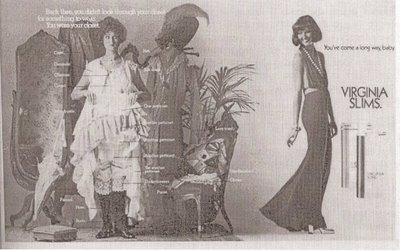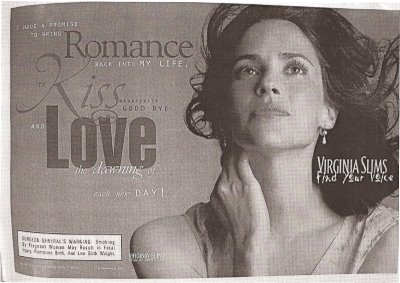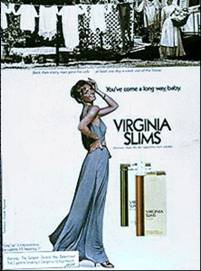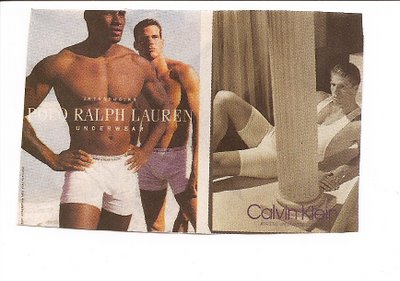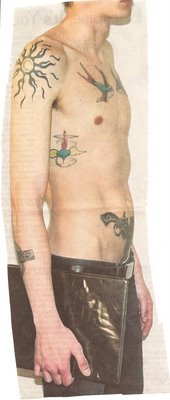This bit appears on the Maxim magazine website. It uses rape, and women’s apparent attraction to men who look like rapists, in order to be humorous. I think it’s particularly interesting that it includes a jab at a Republican (or is it just “the establishment”?). If they are obviously leftist/anti-establishment, are we to believe that they must be good guys, therefore this use of rape for comedic value is okay? Or is this just another manifestation of the equal opportunity insult comedy found in products like South Park and Knocked Up? There is a lot going on here and I’m pretty sure I have yet to fully grasp it. Any thoughts?[youtube]http://www.youtube.com/watch?v=EVcyNANK5cY[/youtube]
gender
Text: “Back then, you didn’t look through your closet for something to wear. You wore your closet. You’ve come a long way, baby.”
Find your voice with Virginia Slims.
This is a Virginia Slims ad from 1978. The picture above is of a woman hanging laundry out to dry and the text says, “Back then, every man gave his wife at least one day a week out of the house. You’ve come a long way, baby.”
I’m using this when I talk about the commodification of the women’s movement and how freedom has been turned into something you buy. I also like the vague “back then,” used to make now seem so much better in every way.
Here’s an ad for breast implants:[youtube]http://www.youtube.com/watch?v=P8RL9Wm5-n4[/youtube] Clearly in this situation the solution is to get breast implants, not a new date.The company’s website is here.This ad encourages women to be envious of “perfect” women and to compare themselves unfavorably:[youtube]http://www.youtube.com/watch?v=arf9LzdIY2s[/youtube] Try plastic surgery if your eating disorder doesn’t do the job:[youtube]http://www.youtube.com/watch?v=HzTPOAzgwQE[/youtube] The center is still in business, but I think a different doctor is in charge now.
Gwen Sharp is an associate professor of sociology at Nevada State College. You can follow her on Twitter at @gwensharpnv.
This commercial affirms the notion that only women can be expected to do housework because children and husbands are absolutely useless.
[youtube]https://www.youtube.com/watch?v=4fwTtJZ6Db4[/youtube]
I find the wife’s acceptance of her husbands ass-ish behavior (still her “best friend”) particularly disheartening.
Lisa Wade, PhD is an Associate Professor at Tulane University. She is the author of American Hookup, a book about college sexual culture; a textbook about gender; and a forthcoming introductory text: Terrible Magnificent Sociology. You can follow her on Twitter and Instagram.
Axe body spray is so powerful, a woman will give up all her dreams and become putty in your hands if you wear it.

Axe and Dove are owned by the same company, so keep that in mind when you encounter the “pro-woman” Dove ad campaigns.
Today Gwen and I went to the by now well-known Bodies exhibit that displays preserved human cadavers, purportedly so we can learn more about the human body (and give up smoking).
As we went in we joked about how there probably wouldn’t be any female bodies until the part on reproduction. We were royally pissed off to discover that we were right. This is a great illustration of the way in which men are neutral and women deviants from the standard (that is, men are people and women are women). The first 8 or so bodies were all male and all in action doing masculine things.
The first female body we encountered (there were only two out of more than a dozen) stood immediately outside the fetal development hall and alongside the dissections of the genitals and reproductive organs.* Not only was this the first female, she was arranged not in action, but in a pose for the male gaze. She was standing with her hands on her hips, with her breasts and hips thrust forward, and on her tip toes as if she were wearing high heels. We couldn’t find any pictures of her on the web (and we weren’t allowed to take any), but we did find an image of a female cadaver from another exhibit. She was both pregnant (fulfilling her biological destiny) and positioned like a pin up (fulfilling her role as sexual object for men). So, in addition to marginalizing the female body, they gendered both male and female bodies. Male bodies are on the move, but female bodies are good for only two things: babies and sexual provocation.
The last body (male) had a sign over it that said “Your Body” because, of course, the male body is just the neutral human body that represents us all.
* As we entered the fetal development hall there was a sign that warned people that they should take a second and think about whether they wanted to see the fetuses, while assuring us that all of them died of natural causes (that is, not abortion). I think it’s bizarre that we’re supposed to find these fetal bodies disturbing, but not the bodies of people who lived lives and loved others and were loved and all that good stuff. There is something weird about the priorities here, as if the fetuses were somehow more human than the adults. Also, while we were looking at the deformed fetuses, a woman standing next to us said that all teenagers should have to see the deformed fetuses because “that’s what gonna happen” if they start having sex.
Lisa Wade, PhD is an Associate Professor at Tulane University. She is the author of American Hookup, a book about college sexual culture; a textbook about gender; and a forthcoming introductory text: Terrible Magnificent Sociology. You can follow her on Twitter and Instagram.
Text: “Back then, you didn’t look through your closet for something to wear. You wore your closet. You’ve come a long way, baby.”
Here’s an ad for breast implants:[youtube]http://www.youtube.com/watch?v=P8RL9Wm5-n4[/youtube] Clearly in this situation the solution is to get breast implants, not a new date.The company’s website is here.This ad encourages women to be envious of “perfect” women and to compare themselves unfavorably:[youtube]http://www.youtube.com/watch?v=arf9LzdIY2s[/youtube] Try plastic surgery if your eating disorder doesn’t do the job:[youtube]http://www.youtube.com/watch?v=HzTPOAzgwQE[/youtube] The center is still in business, but I think a different doctor is in charge now.
Gwen Sharp is an associate professor of sociology at Nevada State College. You can follow her on Twitter at @gwensharpnv.
This commercial affirms the notion that only women can be expected to do housework because children and husbands are absolutely useless.
[youtube]https://www.youtube.com/watch?v=4fwTtJZ6Db4[/youtube]
I find the wife’s acceptance of her husbands ass-ish behavior (still her “best friend”) particularly disheartening.
Lisa Wade, PhD is an Associate Professor at Tulane University. She is the author of American Hookup, a book about college sexual culture; a textbook about gender; and a forthcoming introductory text: Terrible Magnificent Sociology. You can follow her on Twitter and Instagram.
Axe body spray is so powerful, a woman will give up all her dreams and become putty in your hands if you wear it.
Axe and Dove are owned by the same company, so keep that in mind when you encounter the “pro-woman” Dove ad campaigns.
Today Gwen and I went to the by now well-known Bodies exhibit that displays preserved human cadavers, purportedly so we can learn more about the human body (and give up smoking).
As we went in we joked about how there probably wouldn’t be any female bodies until the part on reproduction. We were royally pissed off to discover that we were right. This is a great illustration of the way in which men are neutral and women deviants from the standard (that is, men are people and women are women). The first 8 or so bodies were all male and all in action doing masculine things.
The first female body we encountered (there were only two out of more than a dozen) stood immediately outside the fetal development hall and alongside the dissections of the genitals and reproductive organs.* Not only was this the first female, she was arranged not in action, but in a pose for the male gaze. She was standing with her hands on her hips, with her breasts and hips thrust forward, and on her tip toes as if she were wearing high heels. We couldn’t find any pictures of her on the web (and we weren’t allowed to take any), but we did find an image of a female cadaver from another exhibit. She was both pregnant (fulfilling her biological destiny) and positioned like a pin up (fulfilling her role as sexual object for men). So, in addition to marginalizing the female body, they gendered both male and female bodies. Male bodies are on the move, but female bodies are good for only two things: babies and sexual provocation.
The last body (male) had a sign over it that said “Your Body” because, of course, the male body is just the neutral human body that represents us all.
* As we entered the fetal development hall there was a sign that warned people that they should take a second and think about whether they wanted to see the fetuses, while assuring us that all of them died of natural causes (that is, not abortion). I think it’s bizarre that we’re supposed to find these fetal bodies disturbing, but not the bodies of people who lived lives and loved others and were loved and all that good stuff. There is something weird about the priorities here, as if the fetuses were somehow more human than the adults. Also, while we were looking at the deformed fetuses, a woman standing next to us said that all teenagers should have to see the deformed fetuses because “that’s what gonna happen” if they start having sex.
Lisa Wade, PhD is an Associate Professor at Tulane University. She is the author of American Hookup, a book about college sexual culture; a textbook about gender; and a forthcoming introductory text: Terrible Magnificent Sociology. You can follow her on Twitter and Instagram.

